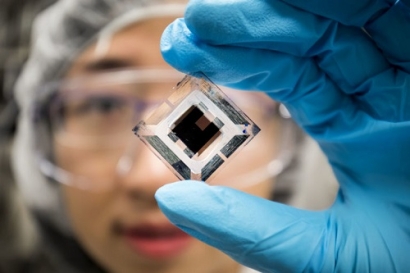
“Organic photovoltaics can potentially cut way down on the total solar energy system cost, making solar a truly ubiquitous clean energy source,” said Stephen Forrest, the Peter A. Franken Distinguished University Professor of Engineering and Paul G. Goebel Professor of Engineering, who led the work.
At 15 percent efficiency and given a 20-year lifetime, researchers estimate organic solar cells could produce electricity at a cost of less than 7 cents per kilowatt-hour. In comparison, the average cost of electricity in the U.S. was 10.5 cents per kilowatt-hour in 2017, according to the U.S. Energy Information Administration.
Carbon-based organic solar cells could potentially be inexpensively manufactured in rolls that are thin enough to bend and curve around structures or within clothing, and made any color, even transparent, to blend in with their environment.
Despite these advantages, organic solar cells have lacked the efficiency required to compete with conventional energy sources.
“For the last couple of years, efficiency for organic photovoltaics was stuck around 11 to 12 percent,” said Xiaozhou Che, a doctoral candidate in the Applied Physics Program and first author of a new study published in Nature Energy.
To improve effciency, the researchers combined multiple advancements in design and process.
First, they stacked two organic solar cells—one capable of absorbing light from the visible spectrum starting at 350 nanometers in wavelength, and another capable of absorbing near-infrared light up to 950 nanometers in wavelength.
Stacking the cells required a breakthrough in process. The team developed interconnecting layers that prevent damage to the first cell, and still allow light and electrical charges to pass through.
“That’s considered a difficult process because there’s a chance the liquid used in processing the top cell will dissolve the layers already deposited underneath,” Che said.
Finally, the team demonstrated that their new design, materials and process have a high fabrication yield of over 95 percent. This means the researchers successfully created almost all devices without short circuits, and is important for scaling up fabrication to an industrial level.
Despite setting record efficiency, the team believes they can push their progress even further.
“We can improve the light absorption to increase electric current, and minimize the energy loss to increase voltage,” Che said. “Based on calculations, an 18 percent efficiency is expected in the near future for this type of multijunction device.”
In addition to Forrest and Che, study co-authors include Yongxi Li, a postdoctoral fellow in the Department of Electrical Engineering and Computer Science, and Yue Qu, a doctoral student in electrical engineering.
The work was supported by the SunShot Program of the Department of Energy and the Department of the Navy, Office of Naval Research.
Photo: Xiaozhou Che, EECS Graduate Research Assistant, holds an organic tandem photovoltaic cell in the EECS Building on April 20, 2018. Image credit: Joseph Xu

